Self-sufficiency in sugar, the goal
By Shirajiv Sirimane
The subject of sugar rises in a family only when a family member is
diagnosed as a diabetic; at other times the subject is hardly spoken at
home. Sugar remains a silent subject at home since people do not receive
a huge sugar bill unlike for some other commodities. However, it is
estimated that every citizen consumes around 35 kilograms of sugar per
year!
|

Minister Lakshman Seneviratne |
One may think that Sri Lanka's top import bill is for vehicles, oil
or fast moving goods.
Therefore one may be surprised to hear that the Democratic Socialist
Republic of Sri Lanka's second highest import bill is for sugar. This is
a staggering US$ 55 billion per year.
To this, the spirit import bill of another US$ 10 to 15 billion too
should be added. The irony is that this entire bill could be saved. Not
only that, an equal amount could be earned as foreign exchange!
It was to achieve this objective that the Government appointed an
experienced Minister, Lakshman Seneviratne to oversee the subject of
sugar. One may say that there is already a Minister of Agriculture and
argue that there is no need for a separate minister for sugar. However,
one should recall that this was not the first time that a separate
minister was appointed for a subject of this nature.
There were ministers appointed to oversee the subjects of paddy,
coconut and many others.
Minister Seneviratne said the Opposition is trying in vain to make
capital out of nothing. He also disclosed that there was also an
imminent sugar crisis looming with most exporting countries such as
Thailand and Brazil deciding to produce ethanol rather than exporting
raw sugar as it was more profitable for them.
He said President Mahinda Rajapaksa has identified the potential in
the industry and had given them guidance to turn around the negative
cycle and make the sugar industry one of the highest foreign exchange
earners in the country.
"Our mission is to produce 700,000mt of sugar and save Rs. 70 billion
of foreign exchange and also look at earning a profit of Rs. 70 billion
by 2019. We are successfully moving towards achieving this goal," he
said.
Positive signs are already visible with the two sugar cane factories
in Sevenagala and Pelwatte showing profits of Rs. 790 million and Rs.
400 million respectively. In addition the sugar industry will also help
produce electricity, thus becoming a major contributor to the economy.
"By producing green energy from sugarcane, Sri Lanka would also get
foreign exchange for carbon emissions from the United Nations," he
added.
''Having duly understood the necessity and the potential President
Rajapaksa allocated 130,000 hectares of land for sugarcane cultivation.
These lands will be cultivated by farmers and they will obtain a steady
income that will improve their living standards, he said. ''Sugarcane
cultivation has a great potential not only to produce sugar, but also to
produce electricity, Extra Neutral Alcohol (ENA), biodiesel, plastic,
fertiliser, compost and many more byproducts.
Cultivation of 130,000 hectares could spearhead the development of
the rural economy and make our farmers economically sound. Further,
saving the country large amounts of foreign exchange which no doubt will
have a positive impact on the national economy", he added.
The sugar requirement of the country is estimated to be 650,000mt per
annum. Sri Lanka imports 94 percent of the sugar requirement, spending a
colossal Rs. 55 billion in foreign exchange. The population increase and
the increase in the incomes are likely to increase the sugar consumption
significantly over the next 10-15 years. By 2020, the demand may
approach one million mt. of sugar.
In 2010 the Government announced the policy to the local sugar
production to meet at least 50 percent of the domestic need within the
next five years.
 |
|
Different stages of
sugarcane cultivation |
This will reduce a large component of the foreign exchange
expenditure to import sugar which could enhance economic development in
rural areas.
In November 2012 President Rajapaksa announced his vision to produce
100 percent of the sugar requirement and to be self-sufficient by 2019
and he further outlined the Government initiatives to achieve this
objective and released 130,000 ha for sugarcane cultivation.
Current status of industry
The sugar industry in Sri Lanka was started during the middle of the
19th century.
There were four sugarcane cultivation-processing complexes at
Hingurana, Kantale, Sevanagala and Pelwatte by the early 90s.
However, the Hingurana and Kantale sugar mills ceased functioning
shortly after their privatisation in the early 90s. Presently, only two
sugar factories namely, Sevanagala and Pelwatte are operating and their
production could meet only less than six percent of the total annual
domestic requirement of sugar, i.e. about 600,000 tonnes.
Sugarcane being a plant with high water economy could be established
in the dry zone and in marginal paddy lands of Sri Lanka where further
development could take place.
There are large tracks of land available for sugarcane cultivation in
the dry zone.
Sugarcane will also give a substantial income to farmers that will no
doubt improve their socio-economic status. Further production of sugar
will give food security and sugarcane bagasse could be used to generate
power and Sri Lanka could produce bio-ethanol to supplement expensive
fossil fuel.
Further, the economy will gain as we could save Rs. 55 billion in
foreign exchange which could be used for other development initiatives.
The potential of this crop is multi-faceted and it could improve the
economy, save foreign exchange, improve livelihood and produce sugar and
bio-ethanol.
Global scenario
Sugar ranks high among food commodities in the diet of people around
the world, is produced in 121 countries, mainly by Brazil, India,
Australia, South Africa, Cuba and Thailand.
Global sugar consumption has risen at an annual rate of about 2.5
percent during the past years with the key drivers being both population
as well as economic growth.
|



